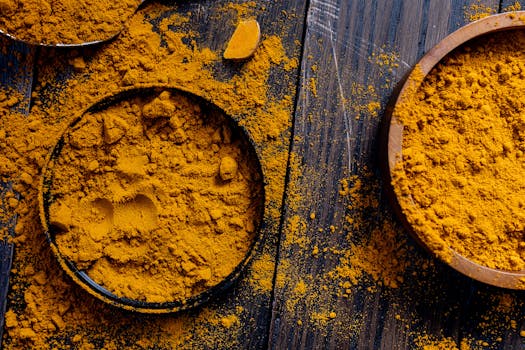Healing with Herbs and Spices: How Herbs Can Be Used for Health and Wellness

Herbs and spices have been used for centuries across different cultures to promote health and wellness. Rich in antioxidants, vitamins, and minerals, they offer natural remedies for various ailments, enhance flavor in meals, and provide a holistic approach to health. Here’s a closer look at some of the most powerful herbs and spices, their healing properties, and practical ways to incorporate them into your daily life.
1. Turmeric (Curcuma longa)
Healing Properties: Contains curcumin, a compound with strong anti-inflammatory and antioxidant effects. It helps reduce inflammation, improves brain function, supports heart health, and may reduce the risk of chronic diseases.
How to Use: Add turmeric powder to soups, stews, smoothies, or golden milk. Combine with black pepper to enhance absorption.
2. Ginger (Zingiber officinale)
Healing Properties: Known for its anti-nausea, anti-inflammatory, and digestive benefits. It also helps relieve pain, improve circulation, and boost the immune system.
How to Use: Fresh ginger can be added to teas, stir-fries, and smoothies. You can also use dried ginger powder in baking, soups, or as a seasoning.
3. Garlic (Allium sativum)
Healing Properties: Garlic is a natural antibiotic and antiviral agent. It helps reduce blood pressure, lower cholesterol, boost the immune system, and has anti-cancer properties.
How to Use: Add raw or cooked garlic to salads, sauces, soups, or stews. Crushing or chopping it releases beneficial compounds.
4. Cinnamon (Cinnamomum verum)
Healing Properties: Helps regulate blood sugar, has anti-inflammatory properties, and contains antioxidants. It also supports heart health and may reduce the risk of neurodegenerative diseases.
How to Use: Sprinkle cinnamon on oatmeal, yogurt, or in smoothies. It can also be added to coffee, tea, or baked goods.
5. Peppermint (Mentha piperita)
Healing Properties: Known for its soothing effect on digestive issues, peppermint helps relieve bloating, indigestion, and headaches. It also has antimicrobial properties.
How to Use: Brew peppermint leaves in hot water for tea, or add fresh leaves to salads and smoothies. Peppermint oil can be inhaled for headache relief.
6. Aloe Vera (Aloe barbadensis)
Healing Properties: Aloe vera is renowned for its healing, anti-inflammatory, and skin-soothing properties. It also aids digestion and boosts the immune system.
How to Use: Use aloe vera gel topically for burns and skin irritations, or consume aloe juice for digestive health.
7. Sage (Salvia officinalis)
Healing Properties: Rich in antioxidants, sage helps improve brain function, supports oral health, and has anti-inflammatory effects.
How to Use: Use sage leaves in cooking (e.g., soups, meats, and stuffing) or steep them to make herbal tea.
8. Rosemary (Rosmarinus officinalis)
Healing Properties: Contains compounds that boost memory, improve digestion, and reduce inflammation. It also has antibacterial and antifungal properties.
How to Use: Add rosemary to roasted meats, potatoes, vegetables, or infuse it in olive oil. It can also be brewed into a tea.
9. Fenugreek (Trigonella foenum-graecum)
Healing Properties: Fenugreek helps regulate blood sugar levels, supports digestion, and boosts milk production in lactating mothers. It may also lower cholesterol.
How to Use: Add fenugreek seeds to curries, stews, and soups, or use fenugreek powder in spice blends.
10. Thyme (Thymus vulgaris)
Healing Properties: Contains thymol, which has antiseptic, antibacterial, and antifungal properties. Thyme also supports respiratory health and improves digestion.
How to Use: Use thyme in marinades, soups, sauces, and stews. It can be brewed into a tea for respiratory relief.
11. African Baobab (Adansonia)
Healing Properties: Baobab is rich in vitamin C, fiber, and antioxidants. It boosts immunity, supports skin health, aids digestion, and helps regulate blood sugar.
How to Use: Use baobab powder in smoothies, juices, yogurts, or sprinkle it over oatmeal.
12. Hibiscus (Hibiscus sabdariffa)
Healing Properties: Known for its high vitamin C content, hibiscus helps lower blood pressure, aids in weight loss, and supports liver health.
How to Use: Brew hibiscus flowers into a tea (hot or cold) or add to salads for a tangy flavor.
13. African Bird's Eye Chili (Piri Piri)
Healing Properties: Contains capsaicin, which helps boost metabolism, reduce pain, and has anti-inflammatory effects.
How to Use: Add fresh or dried piri piri peppers to sauces, marinades, or stews for a spicy kick.
14. Neem (Azadirachta indica)
Healing Properties: Neem leaves have antifungal, antibacterial, and anti-inflammatory properties. They are used for detoxification, skin health, and boosting immunity.
How to Use: Neem tea is popular for detoxification. It can also be applied topically for skin conditions.
15. Rooibos (Aspalathus linearis)
Healing Properties: Caffeine-free and rich in antioxidants, rooibos supports heart health, reduces inflammation, and promotes relaxation.
How to Use: Brew rooibos leaves as a tea or add them to smoothies and desserts.
Tips for Using Herbs and Spices in Daily Life
Start Small: Incorporate small amounts into your meals, gradually increasing as you become accustomed to the flavors.
Use Fresh or Dried: Fresh herbs are ideal, but dried herbs also retain significant health benefits. Store them in airtight containers to maintain potency.
Combine with Healthy Fats: Some herbs, like turmeric, are better absorbed when combined with healthy fats (e.g., olive oil or coconut oil).

